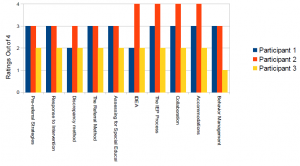Rebecca Blair and Dr. Betty Ashbaker, Department of Counseling Psychology & Special Education
I conducted a survey of 3 BYU elementary education students who completed the CPSE 400 (accommodations for students with disabilities class and are now in the field. Participants were asked to rate how well prepared they felt for various aspects working with students with disabilities in the regular education classroom. Ratings were taken on a scale of 1-4, 1 being unprepared, 2 somewhat unprepared, 3 somewhat prepared, and 4 well prepared. Participants were surveyed on their preparation for the following categories: Pre-referral strategies (strategies used to collect data and aid students before they are referred to special education); Response to Intervention (a tiered system in which students are helped according to their needs; students go through each tier and get referred to special education if their needs are still not met); Discrepancy method of referring students to special education (difference between student’s actual performance/grades and their ability/ IQ according to testing); The referral method (method of referring students to special education); Assessing Students for Special Education; The Individuals with Disabilities Educational Improvement Act (IDEA – the law protecting special education students); The General Education Teacher’s Role in the IEP process (IEP – Individual Education Plan; every special education student is required by law to have one; includes goals and accommodations); Collaborating with Special Education Teachers and other Professionals; Making lesson plan accommodations; Managing Behavior. Here are the results:
Participants were also asked, if they rated categories with a 1 or a 2, why they did so. One survey participant, with the lowest overall ratings for the class, said:
“I personally felt like the CPSE class was the one that prepared me the least for the education field. I don’t feel like I knew what IEP’s were like until I actually taught…Overall, most of the special education knowledge that I have comes from my own personal experiences in the field.”
One participant said, of the categories she gave a 2, that they had rated them with a 2 because they couldn’t remember much about either topic. The categories were the discrepancy method of referring students with disabilities to special education, and special education law, IDEA.
Participants were also asked to give general feedback on the class.
One participant had a mixed review in this section, and offered the following constructive
feedback:
“I think the class provided a foundation but now that I am in the classroom and confronting these kinds of issues daily, I do feel that I am re-learning it all. It is difficult to understand how things work until you are actually in the situation and dealing with real students. If there was a way to give a more authentic experience, I think students would emerge better prepared and with a deeper understanding of how policies and procedures work.”
One of the problems I personally faced in conducting this study was getting email addresses for feedback. Due to IRB restrictions, I was only able to obtain feedback from three people I knew personally who had gone through this program. The limited number of participants made it difficult to obtain a sufficient body of data to draw definite conclusions. However, the results indicate that there are a few areas that should be emphasized in the training of elementary educators. The areas that received the lowest ratings were the discrepancy method of referring students with disabilities, IDEA, and behavior management.
The discrepancy method of referring students to special education is being phased out and replaced by response to intervention. However, it is still important for elementary education teachers to be familiar with it in case it happens to still be used in a school where they work.
IDEA, the law protecting special education students, is one of the most important things for general education teachers to learn about in relation to educating students with disabilities. They are subject to the law as much as special education teachers, and it is crucial for them to be in compliance with it, including meeting IEP goals and making necessary accommodations for students. In order to comply with the laws, teachers need to know them.
The last area that received slightly lower ratings was behavior management. Students with disabilities often have accompanying behavior issues, due sometimes to their lack of ability to function on the same academic level as their peers, and sometimes to their actual disabilities. As such, it is very important that their regular education teachers know how to regulate their behavior in the classroom.
Students with disabilities are required by law to be educated in the least restrictive environment possible to meet their needs. In order for this to happen, all teachers need to be thoroughly educated on dealing with these exceptional students. All students deserve a free and appropriate public education, regardless of any differences or disabilities they may have.

